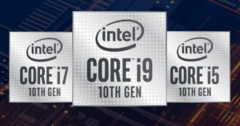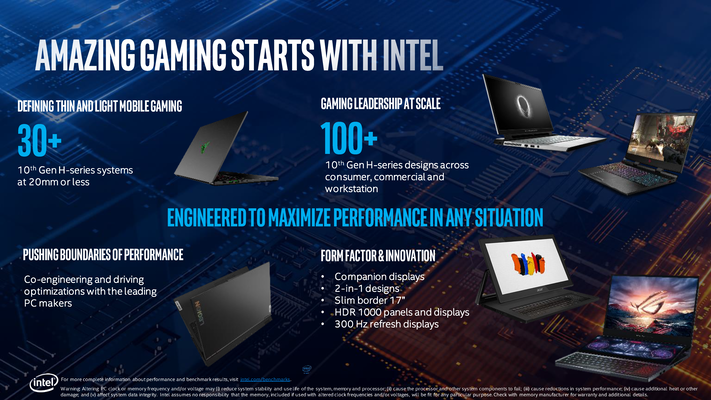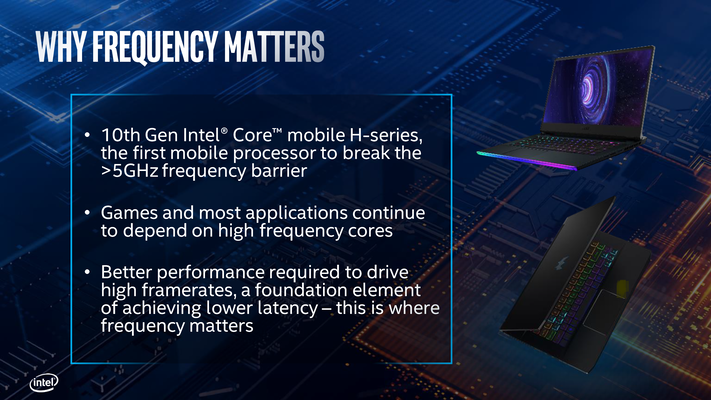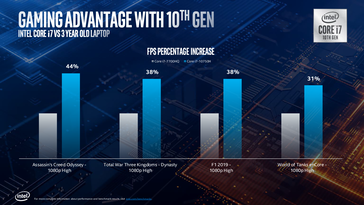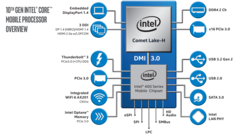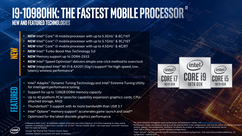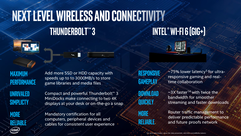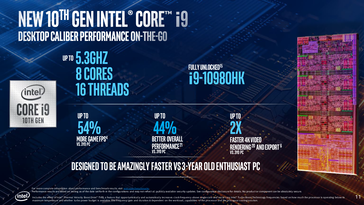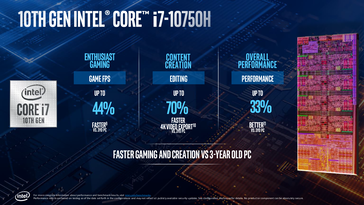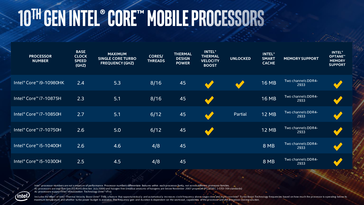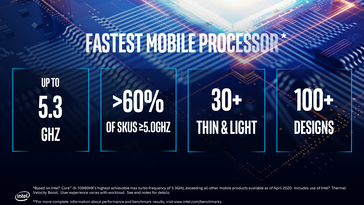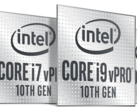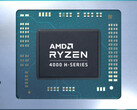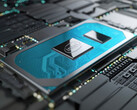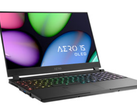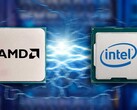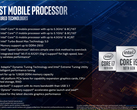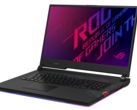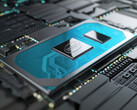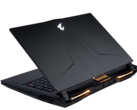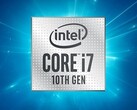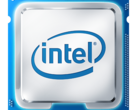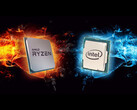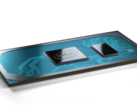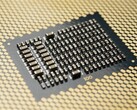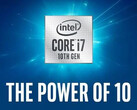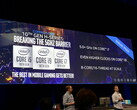Update April 3, 2020: Added additional information about Comet Lake-H chipsets in the Platform Features section.
Introduction
Intel offered a first look at the 10th generation Comet Lake-H during CES 2020 just hours before AMD's big Ryzen 4000 unveil. Intel's growing pangs of sticking with 14 nm not withstanding, rumors were afloat that Intel would accelerate the launch of Comet Lake-H before ceding further ground to AMD's new Ryzen 4000 H-series offerings. Now, Intel is finally making Comet Lake-H broadly available for everyone. Here's a rundown of Intel's new 10th gen H-series product line and some of the new features heading our way.
Breaking the 5 GHz barrier at 45W
The most important and heavily advertised feature in the 10th gen H-series is the single-core boost frequency. Intel reasons that high frequency cores are helpful in games and heavily single-threaded applications, which is the purported advantage Comet Lake-H has over Ryzen 4000-H. Four out of six processors in the Comet Lake-H are being rated as having 5 GHz or greater boosts. In the higher-end SKUs such as the Core i9-10980HK, Core i7-10875H, Core i7-10850H, and Core i7-10750H, Intel uses an improved Thermal Velocity Boost (TVB) method to opportunistically boost clocks to 5 GHz or above.
We will discuss more about TVB shortly.
As such, Intel offers to compare the 10th generation with a 3-year old laptop with the assumption that this would be the major demographic that would be looking for a performance upgrade this year. In this case, the Core i9-10980HK is being compared with the Core i7-7820HK while the Core i7-10750H is being pitted against the Core i7-7700HQ. While we see good improvements in the average FPS, do note that Core i9-10980HK and Core i7-10750H test benches featured the NVIDIA GeForce RTX 2080 Super and RTX 2070 Super, respectively while the Core i7-7820HK and the Core i7-7700HQ systems had an GTX 1080 and a GTX 1070, respectively.
These configurations represent the typical systems a user would be upgrading from and while not truly a measure of gen-to-gen CPU-specific improvements in gaming, it does give a fair idea on what to expect in terms of gaming performance.
Thermal Velocity Boost
The Thermal Velocity Boost (TVB) concept made its first debut with the 8th generation Coffee Lake-H series and is now the de facto single-core boost clock that is being advertised in Intel's marketing materials. Put simply, TVB is an opportunistic overclock that increases clock speeds by 200 MHz if the operating temperature is 65 °C or less and if enough turbo power budget is available. It works in conjunction with Turbo Boost Max, now in its 3rd iteration, which identifies the processor's fastest cores and directs workloads accordingly. TVB is supported on all 10th gen Comet Lake-H SKUs except the Core i5-10400H and the Core i5-10300H.
Intel's press materials do not go into a whole lot detail about TVB, but we could manage to gather some additional information post the launch brief.
TVB can boost up to 200 MHz for the 8-core Core i9-10980HK and this for the top two cores identified by Turbo Boost 3.0 when the temperature is below 65 °C. Between a temperature range of 65 °C and 85 °C, TVB can allow only a 100 MHz boost. In case of the 6-core Core i7-10850H, TVB allows for only a 100 MHz boost and that too, only if the temperature is below 65 °C. We understand that TVB may not boost further in this SKU if the temperature is above this threshold. For cores other than the top-performing ones, Turbo Boost 2.0 comes into play. From what we gather, TVB and Turbo Boost 3.0 do not need a separate driver or software enablement.
Intel would not give us the exact charts, but we believe that in case of the Core i9-10980HK, the max boost would be 5.3 GHz with TVB, 5.1 GHz without TVB but with Turbo Boost 3.0, 4.9 GHz with Turbo Boost 2.0, and 4.4 GHz all-core boost. Similarly, for the Core i7-10850H, the max boost will be 5.1 GHz with TVB, 5 GHz without TVB but with Turbo Boost 3.0, 4.8 or 4.9 GHz with Turbo Boost 2.0, and about 4.4 GHz (?) all-core boost.
Platform Features
The PCH hasn't changed much from the 9th generation Coffee Lake-H Refresh. Comet Lake-H will be based on an Intel 400-series chipset and will offer a maximum of 40 PCIe lanes (Gen3, of course) with 16 of them coming from the CPU. The rest of the PCIe lane count will depend on the chipset being offered.
We get to hear from Intel that there would be a total of three 3W 14 nm chipsets — the HM470 with 16 lanes targeted at most mainstream laptops, the QM480 with 20 lanes targeted at businesses and workstations, and the WM490 with 24 lanes targeted at high-end laptops.
Intel is stressing a lot on single-threaded high frequency performance this generation and as such, is offering a new user-friendly Speed Optimizer tool built into Intel XTU. Intel hopes Speed Optimizer will take the guess work out of overclocking and make it accessible to more users. Intel also has an Adaptix Dynamic Tuning feature for OEMs to configure their laptops for the best sustained boost performance. How exactly Speed Optimizer and Adaptix work together was not fully disclosed.
Memory support is offered up to 128 GB of DDR4-2933 RAM, but Intel told us that support for DDR4-3200 is technically possible. However, that choice is being left to the OEM and is available only for the fully unlocked Core i9-10980HK SKU. Intel has not officially tested DDR4-3200 compatibility with Comet Lake-H.
Update: Intel has published ARK pages for the HM470 and QM480 chipsets. Further details of the WM490 chipset will be revealed at a later date.
| Chipset | Max. PCIe Lanes | Max. USB 2.0 Ports | Max. USB 3.1 Gen1 (5 GB/s) Ports | Max. USB 3.1 Gen2 (10 GB/s) Ports | Max. SATA Ports |
| Intel HM470 | 16 | 14 | 8 | 4 | 4 |
| Intel QM480 | 20 | 14 | 8 | 4 | 4 |
SKUs and Availability
The 10th gen Comet Lake-H pack is led by the Core i9-10980HK, which is an 8-core 16-thread 45W fully unlocked part. Another 8C/16T part that is available is the Core i7-10875H, but it is not unlocked. Further down, we have the 6-core 12-thread Core i7-10850H that is partially unlocked and the Core i7-10750H. The 4-core 8-thread Core i5-10400H and the Core i5-10300H complete the lineup. The UHD Graphics iGPU will be the same as current 9th gen offerings.
Intel is expecting more than 30 thin and light notebooks and more than 100 designs using the Comet Lake-H parts. The first laptops featuring Intel Comet Lake-H are already being made available from major OEMs. How well they stand up to AMD's Renoir Ryzen 4000 onslaught is something that we look forward to testing in upcoming benchmarks comparisons.
Source(s)
Intel Press Brief


 Deutsch
Deutsch English
English Español
Español Français
Français Italiano
Italiano Nederlands
Nederlands Polski
Polski Português
Português Русский
Русский Türkçe
Türkçe Svenska
Svenska Chinese
Chinese Magyar
Magyar